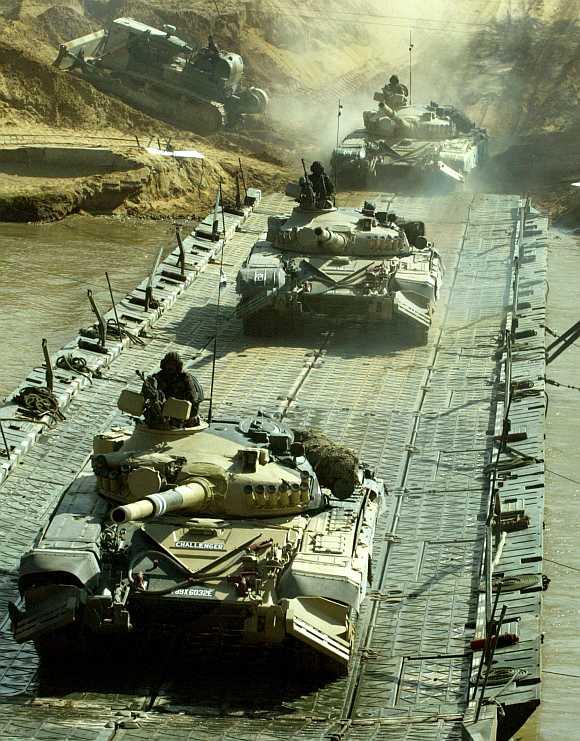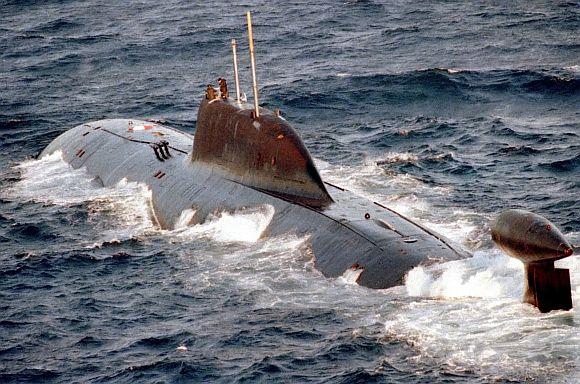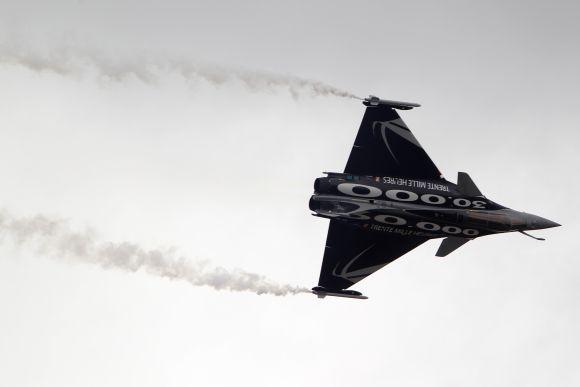Photographs: Kamal Kishore/Reuters
After cost inflation, this year's defence allocation will buy significantly less than last year, says Ajai Shukla
The defence budget for 2012-13, presented in Parliament on Friday, confirms the Indian Army's degeneration into a low technology, manpower-intensive force that spends most of its money on day-to-day running.
While the Navy and Air Force are built up into modern, space-age forces.
Also evident from the figures is that inflation and the slide in the value of the rupee has caused the military's modernisation budget to be effectively reduced for the first time in decades.
More worryingly, India's dependence on foreign weaponry could continue with research and development expenditure slashed in real terms.
This gloomy conclusion was not immediately evident when Finance Minister Pranab Mukherjee announced in Parliament on Saturdaya that the government had allocated Rs 1,93,407 crore for the military in 2012-13, a rise of 13.15 per cent over the current year's revised allocation of Rs 1,70,937 crore.
...
Army modernisation slow; but Navy, IAF push ahead
Image: The DRDO-designed UAV LakshyaPhotographs: http://www.indianuav.com
The capital budget, which is the main source for the procurement of new weaponry, was raised by a seemingly healthy 15 per cent from Rs 69,198 crore last year, to Rs 79,578 crore for 2012-13.
But a different picture emerges when one translates the capital budget into US dollars, import-dependent India's primary currency for arms purchases. Last year's capital budget (at Rs 44.45 per dollar on Apr 1, 2011) was $15.56 billion. This year's capital budget (conservatively assuming an exchange rate of Rs 50 per dollar) translates into $15.91 billion.
"Factor in cost inflation, which is roughly 10-15 per cent per annum for weapons systems, and this year's capital budget will buy significantly less than last year's," said G Balachander of the Delhi-based Institute for Defence Studies and Analysis.
The Defence R&D Organisation, India's main source of indigenous defence systems, must also make do with less. In rupee terms, the R&D allocation of Rs 4,640 crore for 2012-13 just about matches last year's R&D spend of Rs 4,628 crore.
...
Army modernisation slow; but Navy, IAF push ahead
Image: Nuclear-powered attack submarine NerpaBut, given inflation and the falling rupee, and the high percentage of foreign parts in DRDO-built weaponry, the DRDO's spending power will be significantly eroded in the coming year.
Another worrying issue is the Army's slowdown in modernisation. The Navy will spend almost twice as much in the coming year on force modernisation as it will on manpower and running expenses (capital spend of Rs 23,882 crore, vis-a-vis revenue spend of Rs 12,548 crore).
The IAF will be only slightly lower (capital spend: Rs 28,503 crore, vis-a-vis revenue spend of Rs 17,705 crore). In contrast, the Army will spend only Rs 13,803 crore (half the capital expenditure of the much smaller Navy and IAF); while spending Rs 78,114 crore on running expenditure (roughly four times as much as the IAF and six times more than the Navy).
"The Army has always been a manpower-intensive force, given our mountain borders. But its fighting capability will be seriously eroded if modernisation is choked. The Army badly needs new artillery, the helicopter fleet is obsolescent, there are hardly any serviceable attack helicopters, and night fighting capability remains a gaping hole. Most importantly, the infantry, which is operationally committed around the year, must be modernised urgently," said Lt Gen Pradeep Khanna, who retired last year as the chief of the Army's southern command.
...
Army modernisation slow; but Navy, IAF push ahead
Image: A Dassault Rafale fighter jet takes part in a flying display during an air show in ParisPhotographs: Pascal Rossignol/Reuters
A key reason for the IAF emerging as the biggest beneficiary of the capital budget is the expected signing of a contract this year for 126 Rafale medium multi-role fighters.
Normally, 15 per cent of the overall price is paid at the time of signing; with the Rafale contract expected to be for Rs 70,000 crore, the IAF will pay some Rs 10,000 crore this year, with the balance distributed over the coming decade.
The IAF is also making annual payments for the earlier contracts for the American C-130J Super Hercules and C-17 Globemaster III transport aircraft. A contract could also be signed this year for 197 light utility helicopters, and for urgently needed trainer aircraft for rookie IAF pilots.
Similarly, the Navy is budgeting for the impending contract for Project 17A frigates that will be built in Mazagon Dock Ltd, Mumbai and Garden Reach Shipbuilders and Engineers Kolkata.
It is also making annual payments for several ongoing warship programmes: Project 28 anti-submarine corvettes being built by GRSE; and Project 75 Scorpene submarines, and Project 15A and 15B destroyers being built at MDL. In addition, it is paying Boeing for the P8I Poseidon multi-mission maritime aircraft that are being built in the US.
On an average, more than two-thirds of any year's capital budget is pre-committed towards annual installments for defence contracts concluded earlier. Weapons platforms are often paid for over a decade or so. Just about 30 per cent of any year's capital budget goes towards new contracts.
Earlier this month, China had announced that it would spend $106 billion (670 billion Yuan) on its military in 2013. Defence experts estimate that Beijing actually spends 50-100 per cent more than the declared figure. Like India, China too has steadily increased defence spending in line with its economic growth.






article